Abstract
Bronchodilatation was produced in normal subjects by the inhalation of atropine, a parasympatholytic agent, and isoproterenol, a beta adrenergic stimulator. Density dependence of maximal expiratory flow (Vmax), expressed as a ratio of Vmax with an 80% helium-20% oxygen gas mixture to Vmax with air at isolung volumes, indicated that the predominant flow regimes across upstream airways changed differently after each agent was given separately. After atropine Vmax increased, elastic recoil pressure did not change, and density dependence decreased. Utilizing the equal pressure points analysis which defines upstream and downstream segments of the intrathoracic airways at flow limitation, these results suggest a greater relative dilatation of the larger upstream airways such that more of the driving pressure is dissipated across the smaller airways in which flow is less dependent upon gas density. After isoproterenol Vmax increased, elastic recoil pressure did not change, and density dependence increased. This suggests a preferential dilatation of the smaller and more peripheral airways with less density-dependent flow regimes such that more of the driving pressure would be dissipated in the larger airways in which flow is more dependent upon gas density. Systematic decreases after isoproterenol lead independently to the same conclusion. After both agents together, Vmax increased and density dependence and critical alveolar pressures did not change from control, suggesting a relatively uniform dilatation of all the airways comprising the upstream segment.
Full text
PDF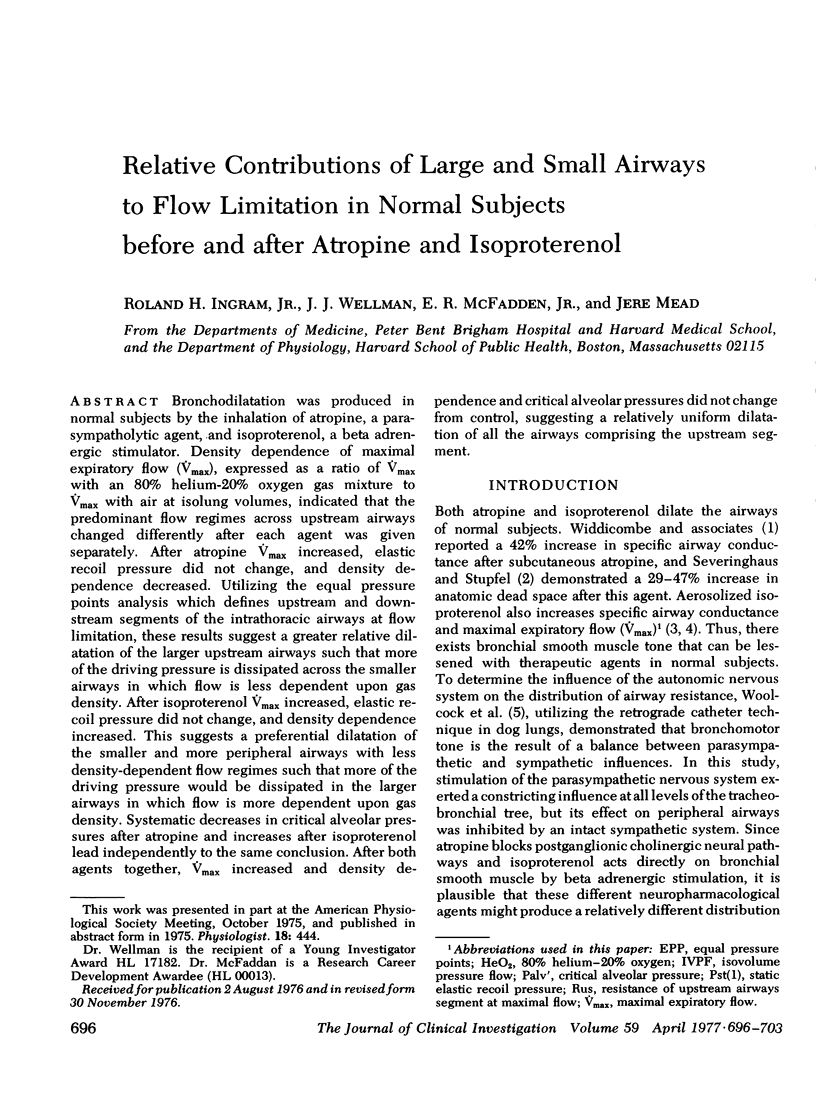
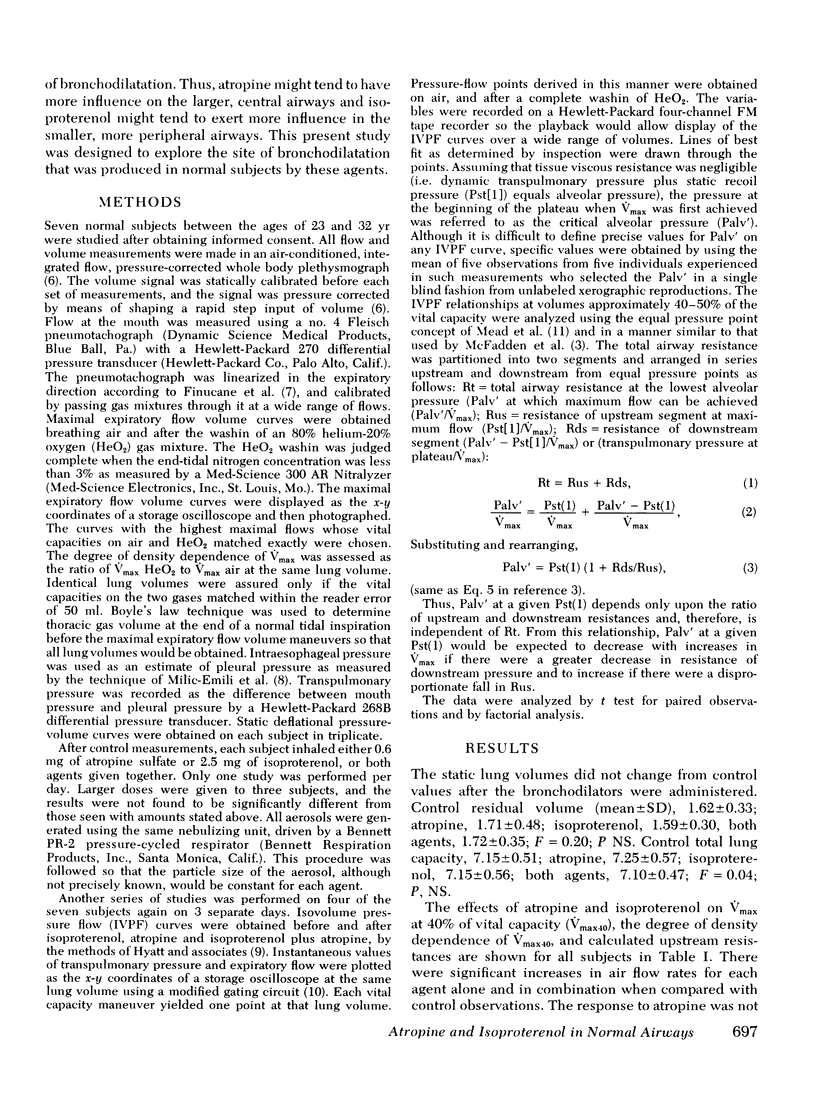
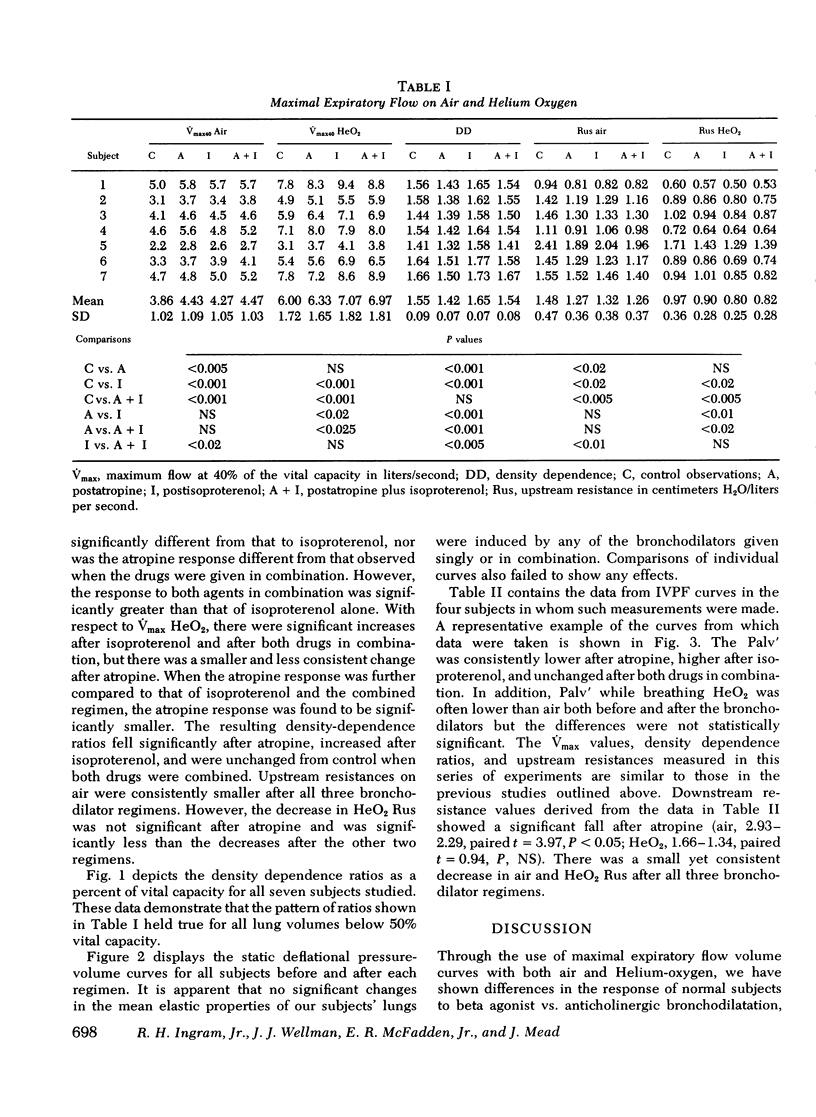
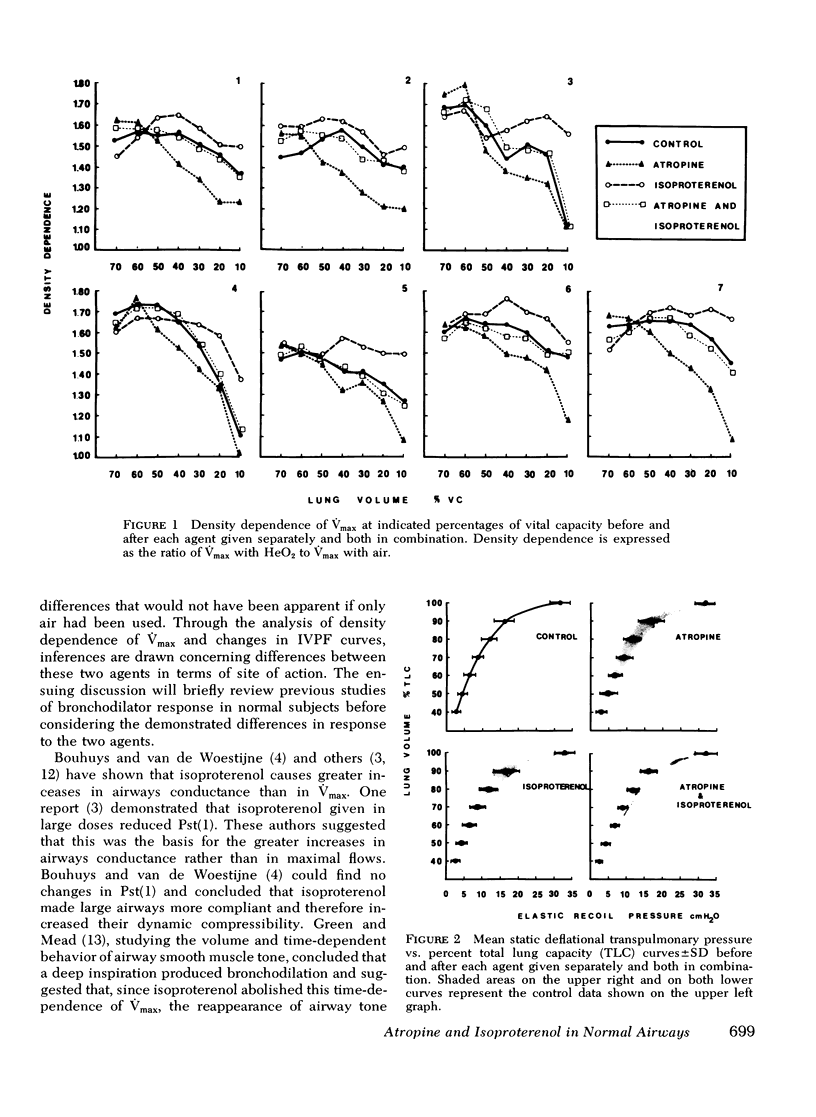

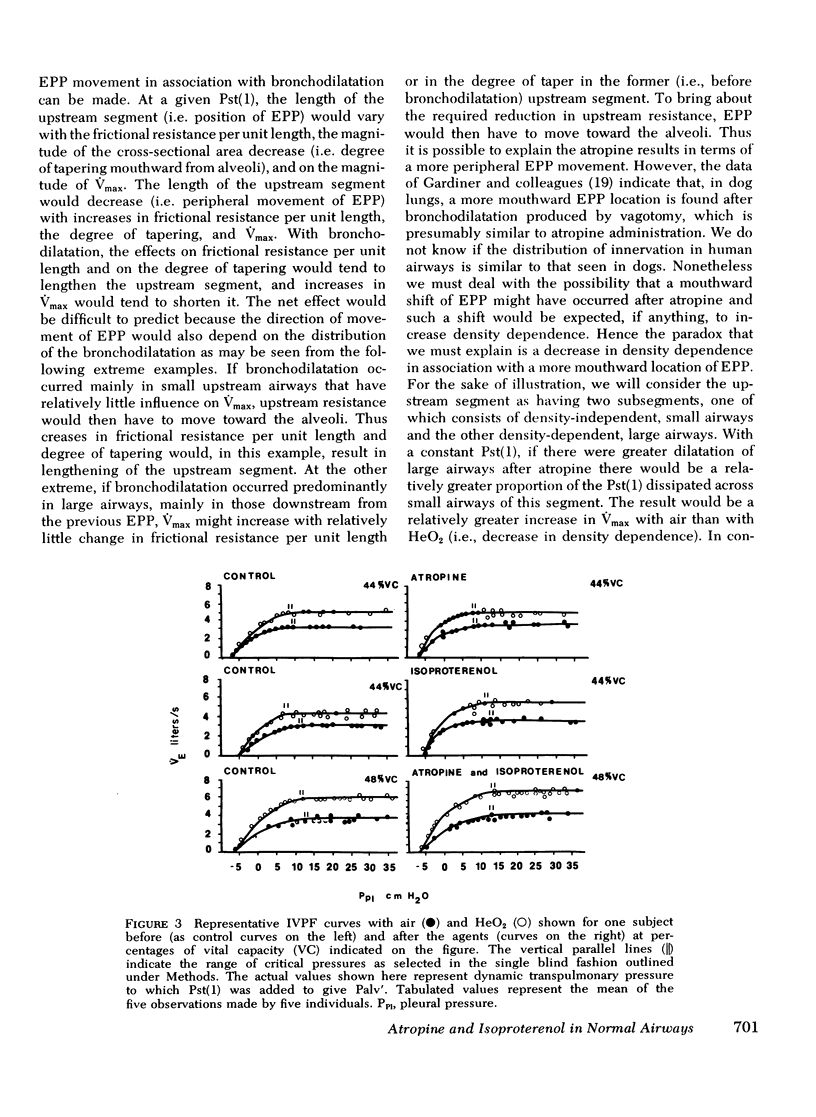
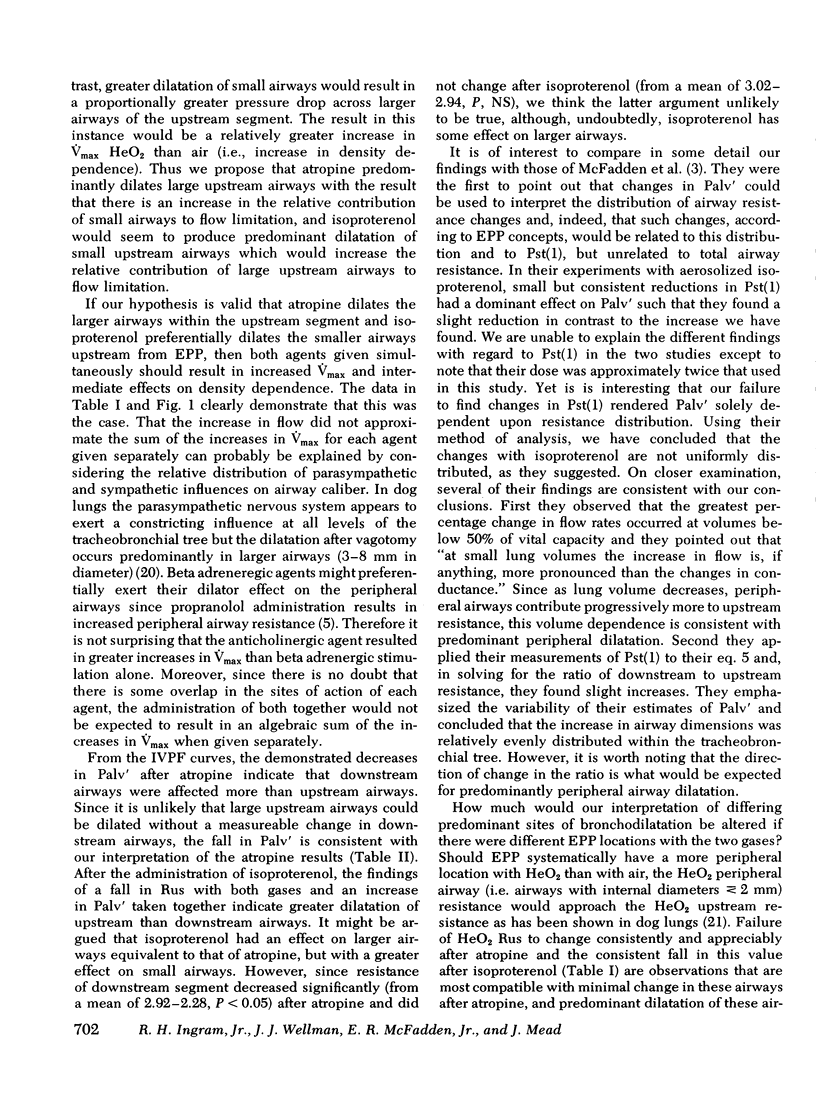
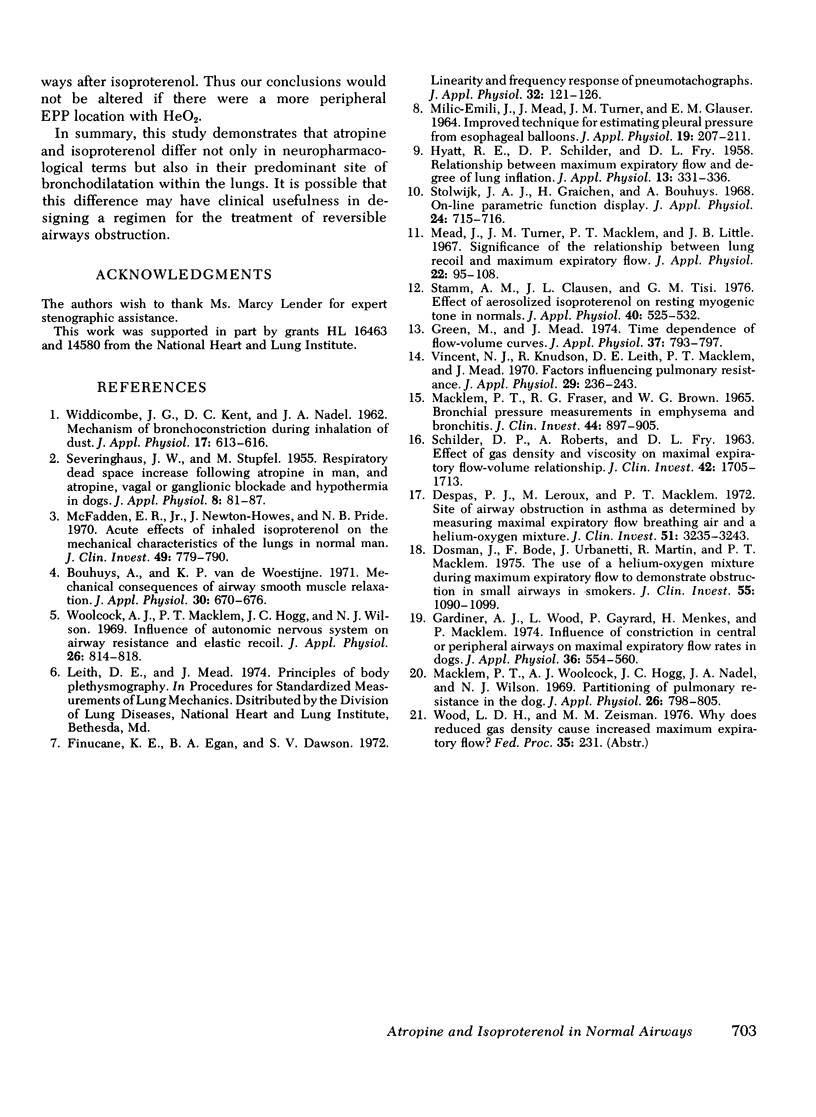
Selected References
These references are in PubMed. This may not be the complete list of references from this article.
- Bouhuys A., Van de Woestijne K. P. Mechanical consequences of airway smooth muscle relaxation. J Appl Physiol. 1971 May;30(5):670–676. doi: 10.1152/jappl.1971.30.5.670. [DOI] [PubMed] [Google Scholar]
- Despas P. J., Leroux M., Macklem P. T. Site of airway obstruction in asthma as determined by measuring maximal expiratory flow breathing air and a helium-oxygen mixture. J Clin Invest. 1972 Dec;51(12):3235–3243. doi: 10.1172/JCI107150. [DOI] [PMC free article] [PubMed] [Google Scholar]
- Dosman J., Bode F., Urbanetti J., Martin R., Macklem P. T. The Use of a Helium-Oxygen Mixture during Maximum Expiratory Flow to Demonstrate Obstruction in Small Airways in Smokers. J Clin Invest. 1975 May;55(5):1090–1099. doi: 10.1172/JCI108010. [DOI] [PMC free article] [PubMed] [Google Scholar]
- Finucane K. E., Egan B. A., Dawson S. V. Linearity and frequency response of pneumotachographs. J Appl Physiol. 1972 Jan;32(1):121–126. doi: 10.1152/jappl.1972.32.1.121. [DOI] [PubMed] [Google Scholar]
- Gardiner A. J., Wood L., Gayrard P., Menkes H., Macklem P. Influence of constriction in central or peripheral airways on maximal expiratory flow rates in dogs. J Appl Physiol. 1974 May;36(5):554–560. doi: 10.1152/jappl.1974.36.5.554. [DOI] [PubMed] [Google Scholar]
- Green M., Mead J. Time dependence of flow-volume curves. J Appl Physiol. 1974 Dec;37(6):793–797. doi: 10.1152/jappl.1974.37.6.793. [DOI] [PubMed] [Google Scholar]
- HYATT R. E., SCHILDER D. P., FRY D. L. Relationship between maximum expiratory flow and degree of lung inflation. J Appl Physiol. 1958 Nov;13(3):331–336. doi: 10.1152/jappl.1958.13.3.331. [DOI] [PubMed] [Google Scholar]
- MACKLEM P. T., FRASER R. G., BROWN W. G. BRONCHIAL PRESSURE MEASUREMENTS IN EMPHYSEMA AND BRONCHITIS. J Clin Invest. 1965 Jun;44:897–905. doi: 10.1172/JCI105206. [DOI] [PMC free article] [PubMed] [Google Scholar]
- MILIC-EMILI J., MEAD J., TURNER J. M., GLAUSER E. M. IMPROVED TECHNIQUE FOR ESTIMATING PLEURAL PRESSURE FROM ESOPHAGEAL BALLOONS. J Appl Physiol. 1964 Mar;19:207–211. doi: 10.1152/jappl.1964.19.2.207. [DOI] [PubMed] [Google Scholar]
- Macklem P. T., Woolcock A. J., Hogg J. C., Nadel J. A., Wilson N. J. Partitioning of pulmonary resistance in the dog. J Appl Physiol. 1969 Jun;26(6):798–805. doi: 10.1152/jappl.1969.26.6.798. [DOI] [PubMed] [Google Scholar]
- McFadden E. R., Jr, Newton-Howes J. Acute effects of inhaled isoproterenol on the mechanical characteristics of the lungs in normal man. J Clin Invest. 1970 Apr;49(4):779–790. doi: 10.1172/JCI106291. [DOI] [PMC free article] [PubMed] [Google Scholar]
- Mead J., Turner J. M., Macklem P. T., Little J. B. Significance of the relationship between lung recoil and maximum expiratory flow. J Appl Physiol. 1967 Jan;22(1):95–108. doi: 10.1152/jappl.1967.22.1.95. [DOI] [PubMed] [Google Scholar]
- SCHILDER D. P., ROBERTS A., FRY D. L. EFFECT OF GAS DENSITY AND VISCOSITY ON THE MAXIMAL EXPIRATORY FLOW-VOLUME RELATIONSHIP. J Clin Invest. 1963 Nov;42:1705–1713. doi: 10.1172/JCI104856. [DOI] [PMC free article] [PubMed] [Google Scholar]
- SEVERINGHAUS J. W., STUPFEL M. Respiratory dead space increase following atropine in man, and atropine, vagal or ganglionic blockade and hypothermia in dogs. J Appl Physiol. 1955 Jul;8(1):81–87. doi: 10.1152/jappl.1955.8.1.81. [DOI] [PubMed] [Google Scholar]
- Stamm A. M., Clausen J. L., Tisi G. M. Effect of aerosolized isoproterenol on resting myogenic tone in normals. J Appl Physiol. 1976 Apr;40(4):525–532. doi: 10.1152/jappl.1976.40.4.525. [DOI] [PubMed] [Google Scholar]
- Stolwijk J. A., Graichen H., Bouhuys A. On-line parametric function display. J Appl Physiol. 1968 May;24(5):715–716. doi: 10.1152/jappl.1968.24.5.715. [DOI] [PubMed] [Google Scholar]
- Vincent N. J., Knudson R., Leith D. E., Macklem P. T., Mead J. Factors influencing pulmonary resistance. J Appl Physiol. 1970 Aug;29(2):236–243. doi: 10.1152/jappl.1970.29.2.236. [DOI] [PubMed] [Google Scholar]
- WIDDICOMBE J. G., KENT D. C., NADEL J. A. Mechanism of bronchoconstriction during inhalation of dust. J Appl Physiol. 1962 Jul;17:613–616. doi: 10.1152/jappl.1962.17.4.613. [DOI] [PubMed] [Google Scholar]
- Woolcock J., Macklem P. T., Hogg J. C., Wilson N. J. Influence of autonomic nervous system on airway resistance and elastic recoil. J Appl Physiol. 1969 Jun;26(6):814–818. doi: 10.1152/jappl.1969.26.6.814. [DOI] [PubMed] [Google Scholar]


